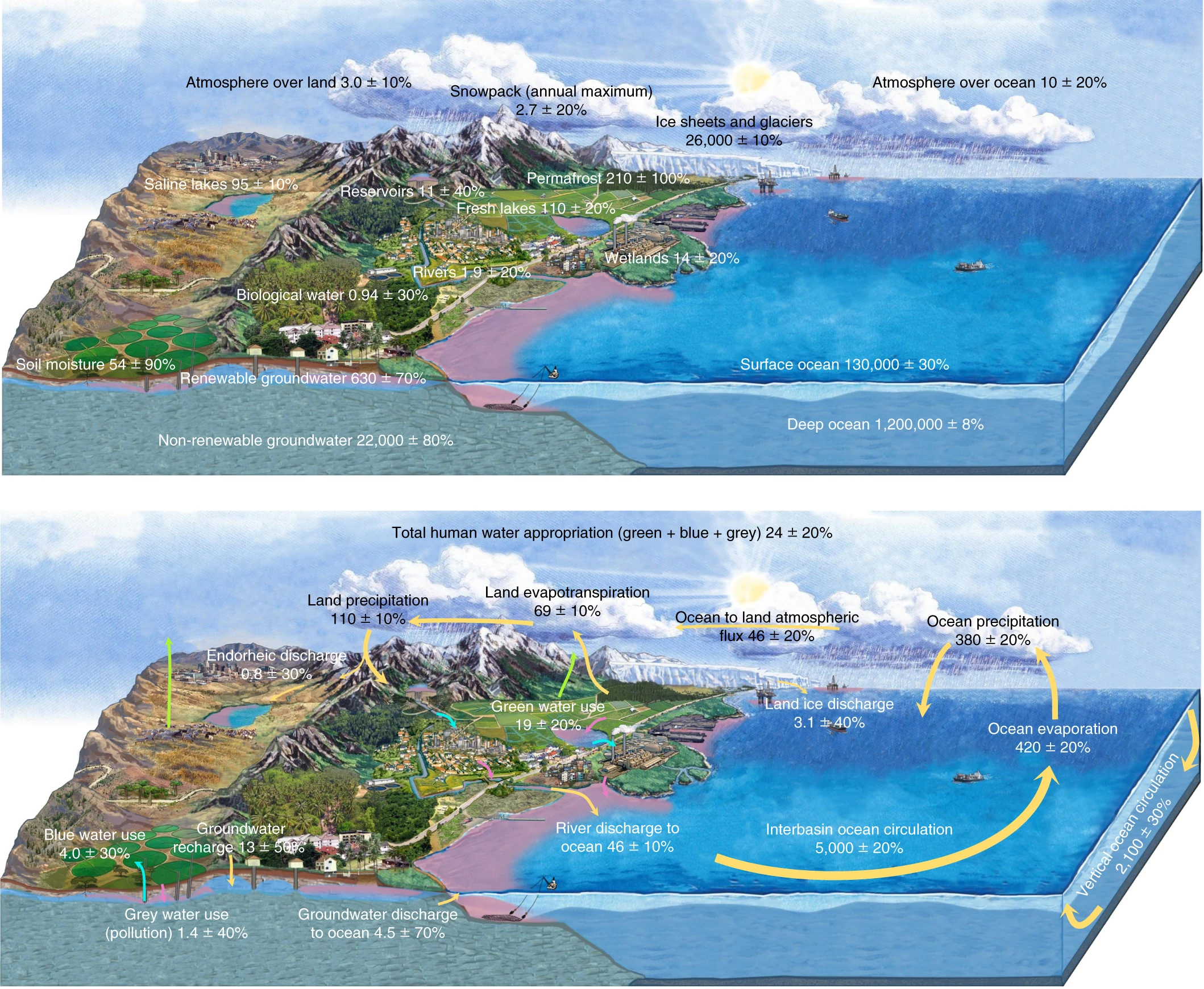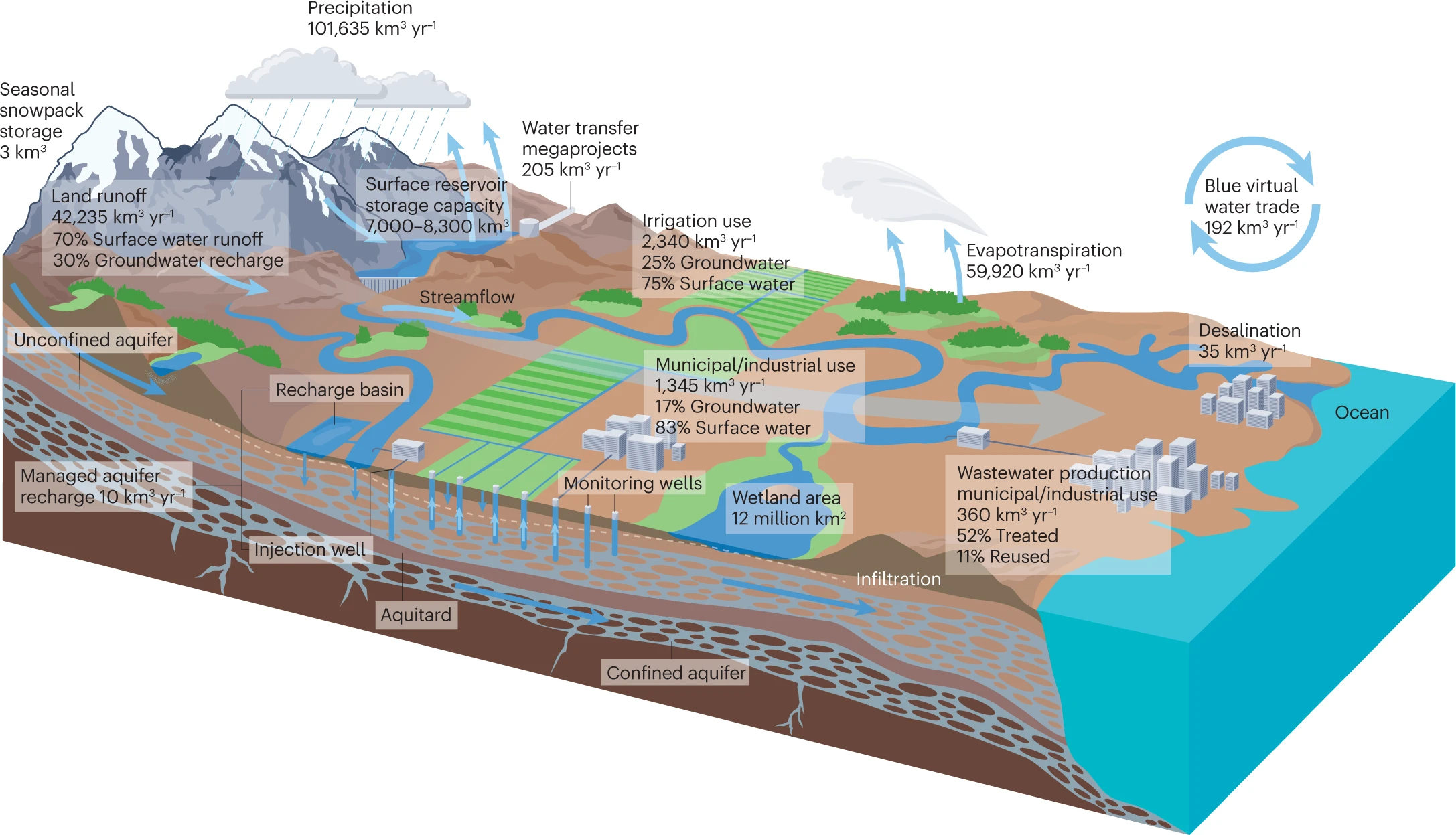Synthesis/Opnions
Overview about rainfall-runoff modelling
Knowledge Gaps in GB’s Perceptual Model
A review paper on perceptual models: reflection on roadmaps and envisions on future development. Although it focuses on GB, the general knowledge can be adopted elsewhere.
Closing the water cycle from observations across scales: Where do we stand?
A hierarchical review paper, published by BAMS, discusses available data sources in hydrologic components on Earth. They separate those components into states (i.e., fresh water storage, atmospheric moisture, soil moisture, groundwater, permafrost and ground ice, snow, glaciers, ice sheets, water in biomass) and fluxes (e.g., evaporation, precipitation, river discharge, groundwater recharge, ice sheet turnover, anthropogenic water useage,
“On a yearly basis, only about 0.008% of the water available on Earth is cycled. In other words, it takes about 12,500 years until all water molecules have completed a full ocean-atmosphere-land-ocean cycle”
“Although the latest generation of reanalysis products, e.g., MERRA-2 or ERA5, show improvements over their predecenssors, trends in many of their water cycle components remain uncertain. Besides, global scale changes are particularly difficult to capture in renalaysis since the moisture and energy balance are not constrained.”
Human domination of the global water cycle absent from depictions and perceptions
The authors reviewed around 300 open-source water cycle diagrams and made complete revisit of the perceiption.

Hydrologic connectivity constrains partitioning of global terrestrial water fluxes Science
Soils evaporate only about 6% water of total water; however, plant transpiration evaporates about 65%. It is a testimony that soil is a substrate not a cause.

Hydrologic uncertainty
A philosophical basis for hydrological uncertainty
By Grey Nearing, Hoshin Gupta, Martyn Clark et al.
Indeed, concepts such as hazard and uncertainty as well as safety, reliability and credibility are not defined until a given scientific method is chosen … (Schlesinger 1975).
uncertainty is the difference between the (unknown) actual truth-value of some Aristotelian proposition and our state of belief about that truth-value.
They break down the uncertainty into 1. the finite experiment problem, 2. the finite hypotheses problem, and 3. the duhem-quine problem (that is essentially there is a collection of hypotheses and you cannot single them out).
Global Drought and Flood: Observation, Modeling, and Prediction (AGU book)
- Progress, Challenges, and Opportunities in Remote Sensing of Drought
- Remote Sensing of Evapotranspiration for Global Drought Monitoring
- Drought Monitoring Using Reservoir Data Collected via Satellite Remote Sensing
- Automatic Near-Real-Time Flood Mapping from Geostationary Low Earth Orbiting Satellite Observations
- Global Flood Observation with Multiple Satellites: Applications in Rio Salado (Argentina) and the Eastern Nile Basin (Pages: 99-121)
- Integrating Earth Observation Data of Floods with Large-Scale Hydrodynamic Models (Pages: 123-135)
- Global Integrated Drought Monitoring with a Multivariate Framework (Pages: 137-145)
- A Probabilistic Framework for Agricultural Drought Forecasting Using the Ensemble Data Assimilation and Bayesian Multivariate Modeling (Pages: 147-164)
- Integrating Soil Moisture Active/Passive Observations with Rainfall Data Using an Analytic Model for Drought Monitoring at the Continental Scale (Pages: 165-180)
- Global Flood Models (Pages: 181-200)
- Calibration of Global Flood Models: Progress, Challenges, and Opportunities (Pages: 201-211)
- Digital Elevation Model and Drainage Network Data Sets for Global Flood and Drought Modeling (Pages: 213-235)
- Fundamental Data Set for Global Drought and Flood Modeling: Land Use and Land Cover (Pages: 237-249)
- Global River Flood Risk Under Climate Change (Pages: 251-270)
- Direct Tangible Damage Classification and Exposure Analysis Using Satellite Images and Media Data (Pages: 271-287)
- Flood Risk and Monitoring Data for Preparedness and Response: From Availability to Use (Pages: 289-306)
- Global Flood Partnership (Pages: 307-322)
- Drought and Flood Monitoring and Forecasting: Challenges and Opportunities Ahead (Pages: 323-326)
Should we apply bias correction? HESS
According to the recommendation of the Joint Working Group on Forecast Verification Research (JWGFVR), the comparison should be performed between gridded data sets (WWRP 2009-1), with the grid resolution of the models degraded by a factor of 3–4 to take into account numerical filter effects (see e.g. Bauer et al., 2011).
Cases of bias:
- imperfect physical schemes
- boundary feedbacks for RCM, which is strongly sensitive to model physics.
- climate variability (model simulation cannot represent the full length of climate)
- uncertainty using RCM to drive hydrologic model
The terrestrial water cycle in a warming world. Nat. Clim. Chang.
The authors advocate the use of a simply model to describe complex climate change schcemes, instead of using complex model. The underlying rational is that error/uncertainties propagate from the atmosphere to land surface by admitting more uncertainties in land surface processes. So, if atmospheric component is available, use readily available and less uncertain and less complex variables (simple model) instead of complex indices.
Emerging trends in global freshwater availability. Nature
Are soils overrated in hydrology? HESS Opinions
The authors argue soil properties are a “consequence”, rather than a “cause” of water movement. Traditional hydrology that builds on top-down approach to prescribe soils may not be sufficient according to the experiment and observations. It is not the soil that determines the hydrology, it is the interaction between ecosystem and climate.
Global water resources and the role of groundwater in a resilient water future Nat Reivews
This review article written by Bridget Scanlon, one of the giant in groundwater modeling and observation using GRACE.
It lays out current status of challenges in water security from groundwater consumption and recharging. Also discussed current implementations of nature-based solutions.

HIGHLY RECOMMENDED
In this article, authors addressed the global map of changes in fresh water availability with satellite observations and also climate models for projection. Very detailed global-regional analysis across the all continents. The impact of elevated precipitation, human-induced irrigation(mining), climate change, glacier depletion, and so on.
AI tools such as ChatGPT will disrupt hydrology, too
This article articulates the caveats and opportunities of using ChatGPT in hydrology. Currently, ChatGPT has limited knowledge about hydrology (not because it does not know, but more of the ability to understands hydrologic questions). Proper use of it is imperative. However, we should perceive it as a tool instead of a threat.
Science advances
Where should hydrology go? An early-career perspective on the next IAHS Scientific Decade: 2023-2032
The Early-Career community proposed three themes to work on for the next decade:
- Tipping points and thresholds in Hydrology
- intensification of hydrological cycle
- water services under pressure
Local state flood policies and planning
Table of contents
- Remote Sensing hydrology
- Classical hydrology
- Flood Analysis
- Flood-affecting factors
- Detecting Flood from Earth Observation
- Flood Validation, Uncertainty, and Impact
- Flood Database compilation
- Wearher, Hydrology coupling
- Water-Energy Nexus
- Hydrologic connectivity
- Hydrologic signatures
- Hydrologic Modelling
- Reservoir regulations and outflow prediction
- Soil moisture